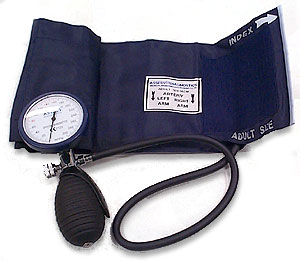Categories
What Is a Sphygmomanometer: Definition & History of Invention

Sphygmomanometer, also called a blood pressure meter or sphygmometer, is an instrument or device that is specifically designed to measure arterial blood pressure. It is composed of an inflatable air-bladder rubber cuff that is wrapped around an upper arm and restricts any blood flow, and a mercury or pressure gauge (mechanical manometer) that actually measures the pressure. It’s a very simple but rather effective medical instrument with the help of which one can accurately measure one’s blood pressure, which, in fact, should be around 120/80 (normal blood pressure reading for adults).
Blood pressure sphygmomanometer (from the Greek ‘sphygmos’ – the pulse or beating of the heart, plus manometer – a tension or pressure measuring device) was firstly introduced in 1881 by Samuel Karl Ritter von Basch, and in 1896 an Italian physician Scipione Riva-Rocci invented a more easily-used version of this device, which in 1901 was modernized and popularized within the medical community by Harvey Cushing. At present, it is one of the most common medical instruments.
Contents
Blood Pressure Meter Types: Manual vs. Electronic Sphygmomanometer
Generally, sphygmomanometers are divided into two common types:
- manual type (stethoscope is required): used by trained practitioners, who can get a basic pressure reading through palpation alone, but stethoscope yields the systolic pressure:
- mercury-based (a gold standard and accurate instrument (usage declined sharply because of the hazards of mercury) that measures blood pressure by observing the mercury’s column height);
- aneroid-based (commonly used in medical practice and unlike mercury manometer requires calibration checks, considered safer than mercury-based because it’s free of mercury, consists of an inflatable single-handed cuff that can be easily applied for self-testing and an automatically inflating and deflating valve, pressure gauge to display the readings);
- digital or electronic type (the most common type of battery-operated sphygmomanometer that is free of mercury, easy-to-operate, and extremely useful for noisy environments and emergency situations, consists of an inflatable single-handed cuff that can be easily applied for self-testing and an automatically inflating and deflating valve, digital monitor to display the readings).
Parts of Sphygmomanometer: Settings Where Sphygmomanometer Is Encountered
Blood pressure sphygmomanometer consists of the following parts: an inflation mechanism which may be a hand-operated bulb or electrically-operated pump of valve, an inflatable cuff that is typically wrapped around an upper arm, and a measuring unit (mercury manometer, aneroid gauge, wrist monitor) that displays the reading of a person’s blood pressure. If you want to obtain as accurate reading as possible, take special attention and care about appropriateness of a cuff size for a person whose blood pressure is being measured. It means that adults or children with larger or smaller arms than of an average size will require special-sized cuffs corresponding to their specific needs.
What concerns settings where a sphygmomanometer is typically used, we may include here the following variety:
- hospital;
- ambulance;
- primary care clinic;
- professional office;
- dental office;
- home;
- other retail establishment.
How to Measure Blood Pressure With Sphygmomanometer: Operational Principle of a Typical Sphygmomanometer

Blood pressure, which is measured with sphygmomanometer, can be influenced by many factors, such as the condition of the arterial walls, the resistance, flow, quantity and quality of blood that circulates through the heart. The blood pressure depends on the abovementioned factors, meaning that if an arterial blood flow is restricted, then the blood pressure readings (systolic pressure is recorded first, diastolic pressure goes second) will be respectively higher. What pressure is called systolic or diastolic?
Systolic and diastolic are two numbers a blood pressure reading consists of. Systolic is the systole, which is the phase when the heart is forced from the heart into the aorta. Diastolic is the diastole or the period of heart’s resting, when it gets refilled with blood. With every heartbeat the blood pressure is raised to the systolic level, between heartbeats – drops to the diastolic level.
Pressure measuring with the help of a blood pressure sphygmomanometer should be done in the following way:
- seat with one arm slightly bent (with loosely rolled up sleeve or bare);
- place the cuff at the heart level and wrap it around the upper arm (for automatic and aneroid types);
- place the cuff at the heart level and wrap it firmly (not tightly) around the upper arm (for manual-based type);
- leave yourself 5 minutes of resting prior to pressure measuring.



